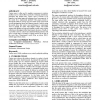Free Online Productivity Tools
i2Speak
i2Symbol
i2OCR
iTex2Img
iWeb2Print
iWeb2Shot
i2Type
iPdf2Split
iPdf2Merge
i2Bopomofo
i2Arabic
i2Style
i2Image
i2PDF
iLatex2Rtf
Sci2ools
SIGCOMM
2009
ACM
2009
ACM
In defense of wireless carrier sense
Carrier sense is often used to regulate concurrency in wireless medium access control (MAC) protocols, balancing interference protection and spatial reuse. Carrier sense is known to be imperfect, and many improved techniques have been proposed. Is the search for a replacement justified? This paper presents a theoretical model for average case two-sender carrier sense based on radio propagation theory and Shannon capacity. Analysis using the model shows that carrier sense performance is surprisingly close to optimal for radios with adaptive bitrate. The model suggests that hidden and exposed terminals usually cause modest reductions in throughput rather than dramatic decreases. Finally, it is possible to choose a fixed sense threshold which performs well across a wide range of scenarios, in large part due to the role of the noise floor. Experimental results from an indoor 802.11 testbed support these claims. Categories and Subject Descriptors C.2.1 [Computer-Communication Networks]: Ne...
| Added | 28 May 2010 |
| Updated | 28 May 2010 |
| Type | Conference |
| Year | 2009 |
| Where | SIGCOMM |
| Authors | Micah Z. Brodsky, Robert T. Morris |
Comments (0)

